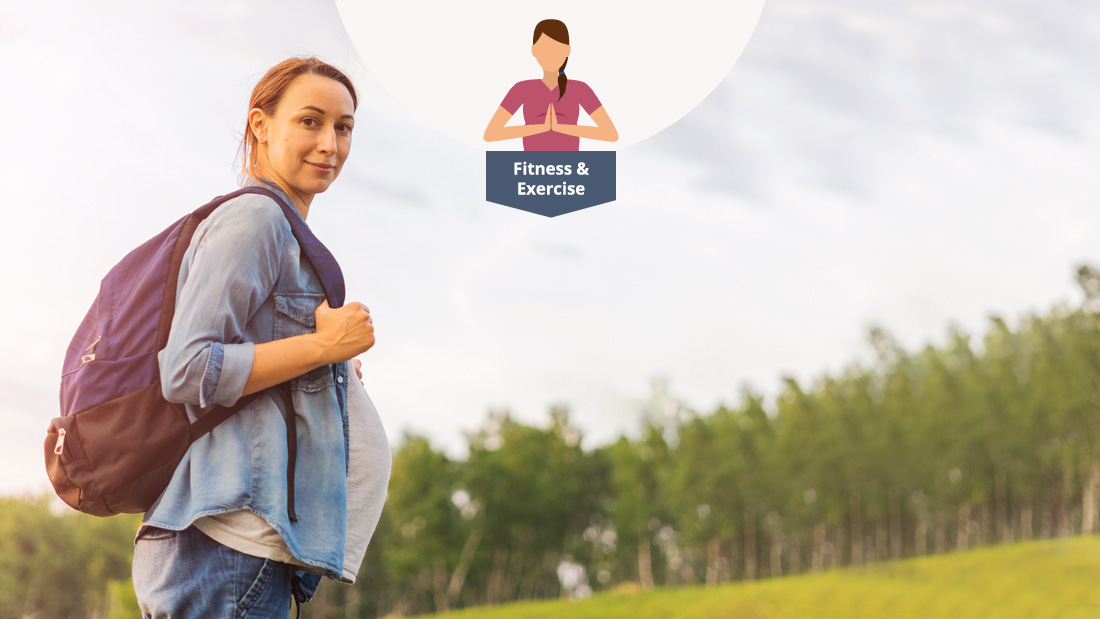
Walk this way to a healthy labour
We may have already mentioned this (just once or twice), but exercise is important throughout pregnancy and especially in the very last weeks. Although it’s likely that the feelings of tiredness are starting to creep back in during the third trimester, keeping up with some form of exercise routine will do wonders for you and your baby.
Exercise can help you:
- sleep better
- cope with low mood and feelings of stress (the release of endorphins enables this)
- reduce feelings of pain and cramps around your body
- reduce the chances of suffering late-stage pregnancy complications, such as gestational diabetes and high blood pressure.
Of course, you may need to make some adjustments to your sessions, depending on the severity of your symptoms in the third trimester, so stay in touch with your body during all exercise and don’t hesitate to stop if you feel yourself beginning to struggle. Don’t try to push through any discomfort for the sake of reaching a goal.
Some of the most effective exercises for late stage pregnancy are also the simplest.
Walking is recommended for all pregnant women regardless of their previous fitness and experience levels. A 20-30 minute walk a few times a week can help improve your circulation (and therefore help prevent varicose veins, a common pregnancy complaint), lift your mood, and keep your weight gain under control.
But walking is also highly recommended both to help induce labour and during labour itself.
How walking around can bring on your baby
If your baby has not already managed to get himself into the best position for birth, then walking in the later stages can help encourage him to shuffle around so his head is pressed against the neck of your womb (your cervix), with his face towards your spine. This is known as the anterior position. Being in this position will also cause your body to release the hormone oxytocin, which can help to trigger contractions. Walking is one of several ways to naturally get labour going. Being upright, will help your baby move right down into your pelvis and then towards your cervix.
Relieving pain during the first stage of labour
In the first stage of labour, walking can help speed the process along and hopefully make it less painful. Staying upright will mean that gravity keeps the baby’s head pressing down against the cervix, causing it to dilate quicker, and the rhythmical movement continues to encourage him to move into the anterior position.
In a report released by the Royal College of Midwives, advice given to midwives to help them improve the birthing experience for pregnant women was to get them “off the bed”. The report mentions the importance of encouraging pregnant women to “feel free to be mobile and try different positions during labour and birth”.
Pelvic rocking
There are other ways to keep mobile in the later stages of pregnancy which can also help lessen the pain of labour. Pelvic rocking is great to do on a fitness ball (also known as a Swiss ball or a birthing ball).
Many maternity wards should have a birthing ball available, but if you’ve been using your own for exercise at home and would rather use that, make sure to take it with you when you go off to the delivery unit.
When a strong contraction hits and as they start to become more frequent, many women find it helpful to rock their pelvis back and forth. Just like walking, this movement helps encourage a straightforward birth by encouraging the baby to move into the anterior position.
Partner’s lending support
Practise leaning against your partner at home, placing your arms over their shoulders and allowing them to take your weight and ease the pressure off your body. You can also do pelvic rocking while leaning on your partner. In this position, they will be able to assist with the rocking motion during a contraction by placing their hands on your hips.
Some labours will be protracted and continuing to stay upright might prove to be really tiring, so it helps to have good support. This is where your partner can play an important role in the process, as not only should they be offering emotional support, but they can also offer physical support, too.
As always, if you’re unsure what is best for you during labour, speak to your midwife or ask an instructor at your antenatal class. These professionals will be able to give you guidance on all the beneficial movements you can use so you’re well prepared when the time comes.
They will help settle any anxiety you may be feeling about the whole process, and being equipped with the knowledge of how to cope with the pain should leave you feeling a lot more confident and ready to take on labour.
Remember – stay up to help your baby go down!


